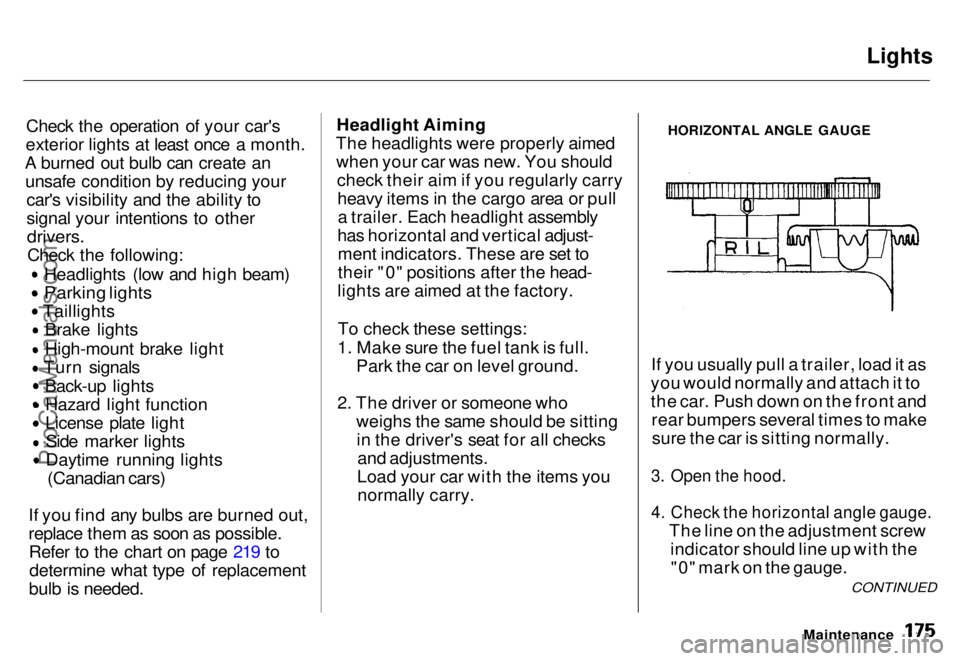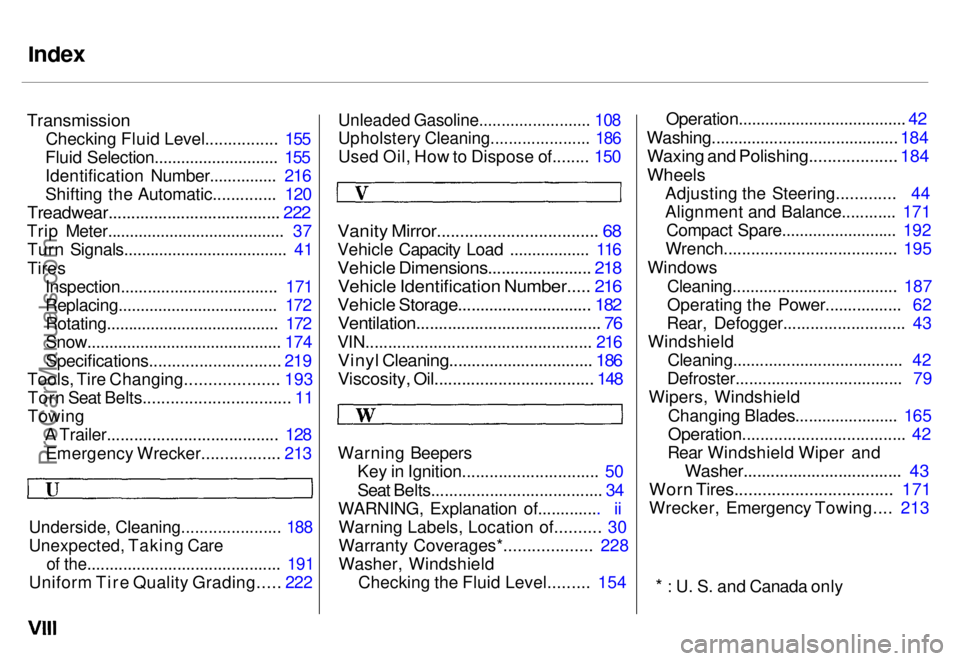Page 132 of 240

Towing a Trailer
Towing Safety Your car will not stop as quickly with a trailer in tow. Leave extra distance
between your car and other vehicles.
Avoid braking or turning suddenly.
This could cause the trailer to
jackknife or possibly turn over.
Keep in mind that your total vehicle
is now much longer. Leave more
room when making turns. The trailer
tracks a smaller arc than the car and
can hit or run over something that
the car misses. When passing another vehicle, make sure the
trailer is clear before changing lanes. The car/trailer combination is more
affected by crosswinds and buffeting.
When being passed by a large
vehicle, keep a constant speed and steer straight ahead. If there is too
much wind buffeting, slow down to
get out of the other vehicle's air
turbulence.
Towing a trailer puts an extra load on your car. You should have your
car serviced according to the
"Maintenance schedule under severe
driving conditions" on page 141. This extra load is magnified when
you are driving in hilly terrain.
Watch the temperature gauge closely when climbing hills. If it getsnear the hot area, turn off the airconditioning (if it is on). If this does
not reduce the heat, it may be
necessary to pull to the side of the
road and wait for the engine to cool.
If the automatic transmission shifts
frequently between 3rd and 4th gears, put it in D3. This will help
prevent the transmission from overheating. Help keep the brakes
from overheating by shifting to a
lower gear when going downhill.
DrivingProCarManuals.comMain Menu s t Table of Contents
Page 133 of 240
Towing a Trailer
If you have to stop while going uphill,
do not hold the car in place by
pressing on the accelerator. This can cause the automatic transmission to
overheat. Use the parking brake or
footbrake.
When parking your car and trailer, especially on a hill, be sure to follow
all the normal precautions. Turn
your front wheels into the curb, set the parking brake firmly, and put the
transmission in Park. In addition, place wheel chocks at each of the
trailer's tires. Backing up with a trailer is difficult
and takes practice. Drive slowly,
make small movements with the steering wheel, and have someone
stand outside to guide you. Grip the
steering wheel on the bottom (rather
than the usual position near the top). Move your hand to the left to get thetrailer to move to the left, and right
to move the trailer right.
DrivingProCarManuals.comMain Menu s t Table of Contents
Page 140 of 240
Maintenance Schedule (Severe Conditions)
Follow the Severe Maintenance
Schedule if you drive your
vehicle MAINLY under one ormore of the following condi-
tions:
Driving less than 8 km (5
miles) per trip or, in freezing
temperatures, driving less
than 16 km (10 miles) per trip. Driving in extremely hot [over 90°F (32°C)] conditions.
Extensive idling or long
periods of stop-and-go driving.
Trailer towing, driving with a car-top carrier, or driving in
mountainous conditions.
Driving on muddy, dusty, or
de-iced roads.
NOTE: If you only
OCCASIONALLY drive under a
"severe" condition, you should
follow the Normal Conditions Maintenance Schedule on the
previous page.
MaintenanceProCarManuals.comMain Menu s t Table of Contents
Page 174 of 240

Lights
Check the operation of your car's
exterior lights at least once a month.
A burned out bulb can create an unsafe condition by reducing your car's visibility and the ability to
signal your intentions to other
drivers.
Check the following: Headlights (low and high beam)
Parking lights
Taillights
Brake lights
High-mount brake light
Turn signals
Back-up lights
Hazard light function
License plate light
Side marker lights
Daytime running lights
(Canadian cars)
If you find any bulbs are burned out,
replace them as soon as possible. Refer to the chart on page 219 todetermine what type of replacement
bulb is needed. Headlight Aiming
The headlights were properly aimed when your car was new. You should check their aim if you regularly carryheavy items in the cargo area or pulla trailer. Each headlight assembly
has horizontal and vertical adjust- ment indicators. These are set to
their "0" positions after the head-
lights are aimed at the factory.
To check these settings:
1. Make sure the fuel tank is full. Park the car on level ground.
2. The driver or someone who weighs the same should be sittingin the driver's seat for all checks and adjustments.
Load your car with the items you normally carry. HORIZONTAL ANGLE GAUGE
If you usually pull a trailer, load it as
you would normally and attach it to
the car. Push down on the front and rear bumpers several times to makesure the car is sitting normally.
3. Open the hood.
4. Check the horizontal angle gauge.
The line on the adjustment screwindicator should line up with the"0" mark on the gauge.
Maintenance
CONTINUEDProCarManuals.comMain Menu s t Table of Contents
Page 239 of 240

Index
Transmission
Checking Fluid Level................ 155
Fluid Selection............................ 155
Identification Number............... 216
Shifting the Automatic.............. 120
Treadwear...................................... 222
Trip Meter........................................ 37 Turn Signals..................................... 41
Tires Inspection................................... 171
Replacing.................................... 172Rotating....................................... 172
Snow............................................ 174
Specifications............................. 219
Tools, Tire Changing.................... 193 Torn Seat Belts................................ 11
Towing A Trailer...................................... 128
Emergency Wrecker................. 213
Underside, Cleaning...................... 188
Unexpected, Taking Care
of the........................................... 191
Uniform Tire Quality Grading..... 222
Unleaded Gasoline......................... 108
Upholstery Cleaning...................... 186
Used Oil, How to Dispose of........ 150
Warning Beepers Key in Ignition..............................
50
Seat Belts..................................... .
34
WARNING, Explanation of.............. ii Warning Labels, Location of.......... 30
Warranty Coverages*................... 228
Washer, Windshield Checking the Fluid Level......... 154
Operation...................................... 42
Washing.......................................... 184
Waxing and Polishing................... 184
Wheels
Adjusting the Steering............. 44
Alignment and Balance............ 171Compact Spare.......................... 192
Wrench...................................... 195
Windows Cleaning..................................... 187
Operating the Power................. 62
Rear, Defogger........................... 43
Windshield Cleaning...................................... 42
Defroster..................................... 79
Wipers, Windshield
Changing Blades....................... 165
Operation.................................... 42
Rear Windshield Wiper and
Washer................................... 43
Worn Tires.................................. 171
Wrecker, Emergency Towing.... 213
* : U. S. and Canada only
Vanity Mirror................................... 68
Vehicle Capacity Load .................. 116
Vehicle Dimensions....................... 218
Vehicle Identification Number..... 216
Vehicle Storage.............................. 182
Ventilation......................................... 76
VIN.................................................. 216
Vinyl Cleaning................................ 186
Viscosity, Oil................................... 148ProCarManuals.comMain Menu s t